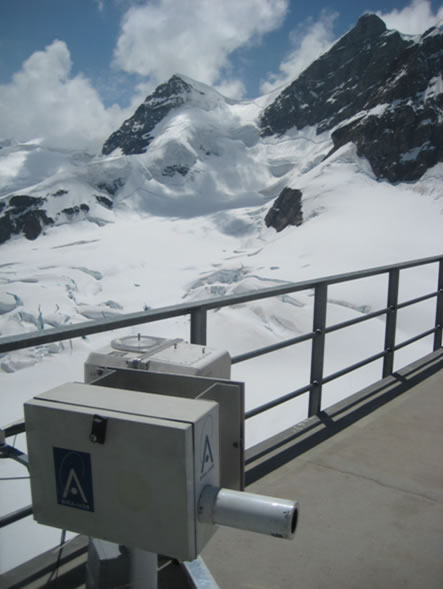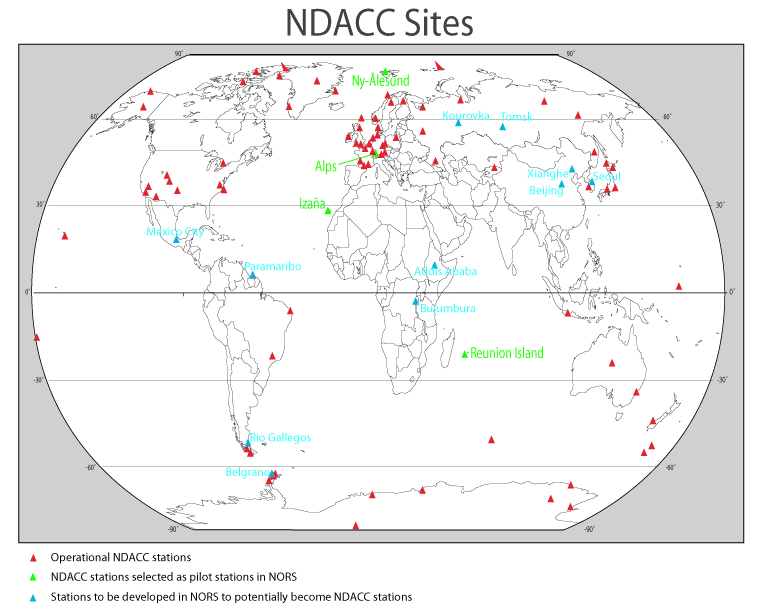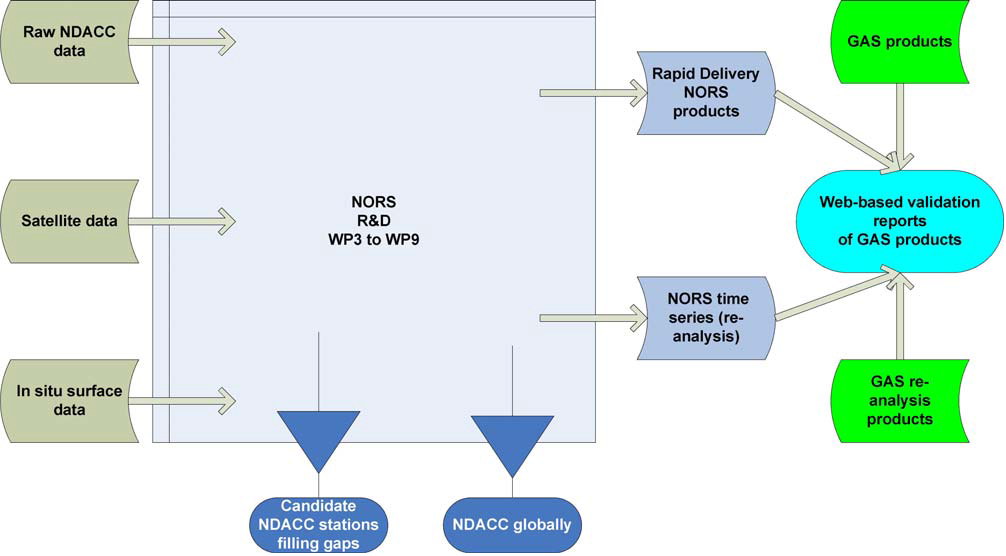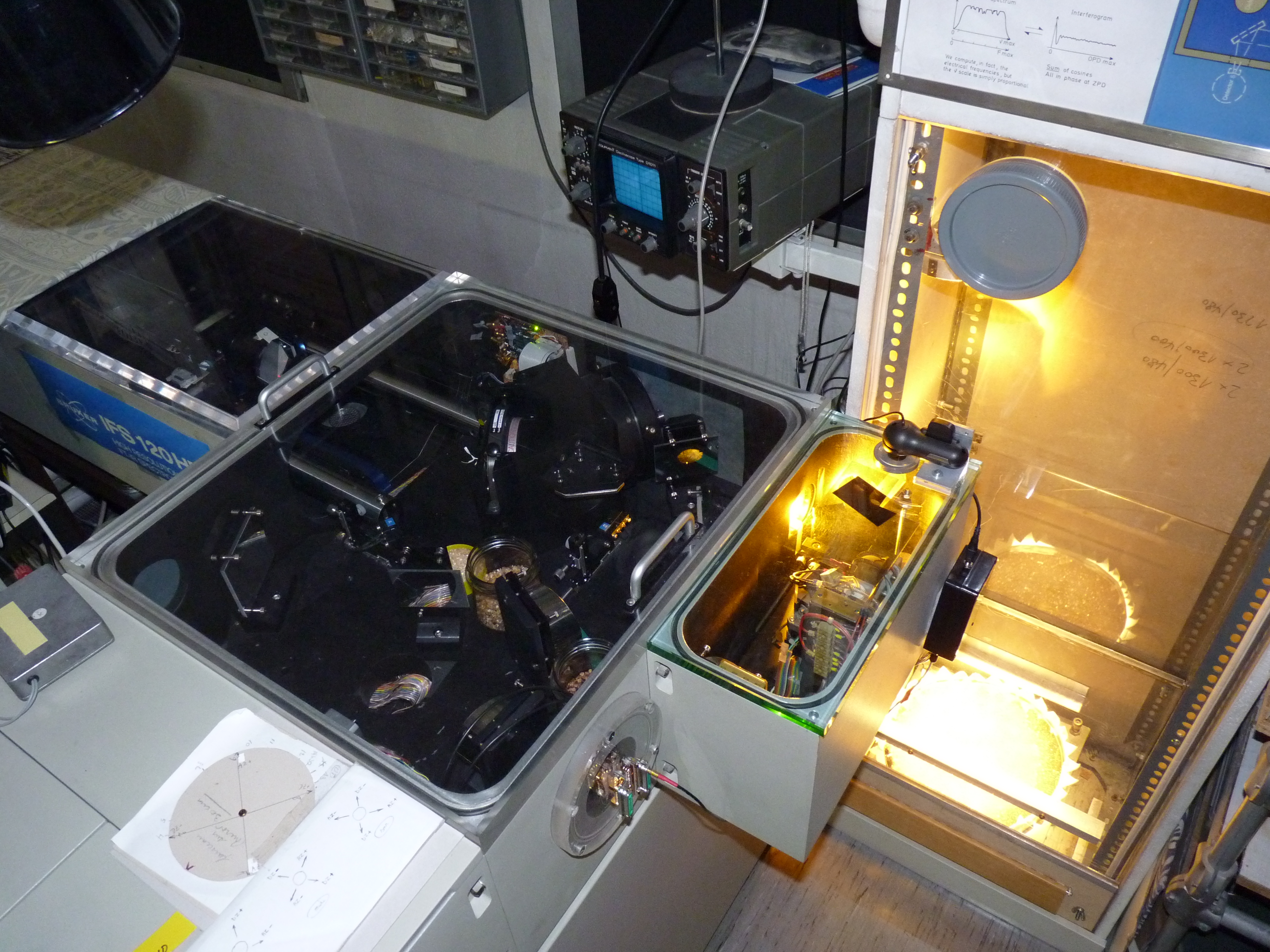Instruments
The four types of instruments included in NORS represent the most important ground-based remote sensing techniques in the field of atmospheric composition. They have rarely been used in the validation of MACC-II products up to now.
- Ozone LIDAR
- Ozone Microwave Radiometer
- FTIR (Fourier Transform InfraRed spectroscopy)
- UV-VIS DOAS (Differential Optical Absorption Spectroscopy)
LIDAR

Microwave Radiometer

FTIR
MAXDOAS

Target data products
The target species in NORS are
- tropospheric and stratospheric ozone columns and vertical profiles up to 70 km altitude;
- tropospheric and stratospheric NO2 columns and profiles;
- lower tropospheric profiles of NO2, H2CO, aerosol extinction;
- tropospheric and stratospheric columns of CO;
- tropospheric and stratospheric columns of CH4.
Sites
In NORS, we will focus on key species for the stratospheric ozone, air quality, and climate areas of GAS at four NDACC sites managed by European partners. NORS will also make an effort to export its achievements to more stations of the global NDACC network, including new stations under development, and to be prepared to include additional species in the near-future. The four pilot stations (Izaña, Reunion Island, the Alps and Ny-Ålesund) were selected for their latitudinal distribution and because each of them hosts a variety of instruments.

Work breakdown
The planned activities have been divided into workpackages (WP) according to the type of work. Many will run in parallel, some are quite independent of the others, some have strong interactions among them (see charts below).
WP1 ensures the overall scientific project management.
WP2 ensures proper dissemination of project results (outreach).
WP3 cares for the development and implementation of automatic processing and formatting (archiving) of the NORS data at the partners sites and the development and implementation of a rapid delivery system of the processed and formatted data to CAS. The data formats will be defined in WP4.
Table 1: Identification of the types of instruments at the 4 NORS stations, and of the partner’s responsibilities
| DOAS | MAXDOAS | FTIR | O3 LIDAR | O3 MW | |
| BIRA-IASB | Alps | Alps | Reunion | ||
| INTA | Izana | ||||
| UBern | Alps | ||||
| KIT | Izana | ||||
| CNRS | Alps, Reunion | Alps, Reunion | |||
| UBremen | Ny-Ålesund | Ny-Ålesund | Ny-Ålesund | ||
| ULg | Alps |
WP4, in addition, includes scientific work aimed at better characterizing the data, among others by comparing data for the same atmospheric parameter from different sources. The metadata associated with the data will be defined and a user guide will be delivered. WP4 also includes an evaluation of the consistency between the ground-based data and the satellite data used in the CAS assimilation chain.
WP5 and WP6 develop new scientific methodologies for integrating data from different sources, in particular in WP5 for tropospheric products (in-situ surface concentration measurements, groundbased remote sensing data and satellite data, with the help of model information) and in WP6 for ozone products.
Table 2: Tropospheric data stations/products/responsible institutes at candidate demonstration sites
| DOAS | MAXDOAS | FTIR | In situ surface | Sat. | Model* | |
| Jungfraujoch | ||||||
| NO2 | BIRA-IASB | BIRA-IASB | ULg | EMPA | EMPA§ | MOZART-4 |
| O3 | BIRA-IASB | ULg | EMPA | WP3000 | MOZART-4 | |
| CO | ULg | EMPA | WP3000 | MOZART-4 | ||
| CH4 | ULg | EMPA | WP3000 | TM5 | ||
| Izana | ||||||
| NO2 | INTA | INTA | KIT | EMPA+ | WP3000 | MOZART-4 |
| O3 | INTA | KIT | EMPA+ | WP3000 | MOZART-4 | |
| CO | KIT | EMPA+ | WP3000 | MOZART-4 | ||
| CH4 | KIT | EMPA+ | WP3000 | TM5 | ||
| Ny Ålesund | ||||||
| NO2 | UBremen | UBremen | UBremen | EMPA+ | WP3000 | MOZART-4 |
| O3 | UBremen | UBremen | EMPA+ | WP3000 | MOZART-4 | |
| CO | UBremen | EMPA+ | WP3000 | MOZART-4 | ||
| CH4 | UBremen | EMPA+ | WP3000 | TM5 | ||
*: Column gives the name of the suggested global chemistry transport model whose output will be used to create profile and column data from surface in-situ measurements (MOZART-4: http://www.acd.ucar.edu/gctm/mozart/, TM5: http://www.phys.uu.nl/~tm5/). As an alternative the global reanalysis products as created in MACC and Copernicus (http://www.gmes-atmosphere.eu/data/) will be considered.
+: In-situ data from Izana and Ny Ålesund will be obtained through the Global Atmosphere Watch data centre for greenhouse gases (WDCGG)
§: New OMI NO2 retrieval with improved quality above complex terrain for central Europe (see http://temis.empa.ch/index.php)
WP7 cares for the delivery of re-analysed time-series of ground-based measurements at the 4 NDACC pilot stations back to 2003 or to the start of the measurements.
WP8 develops and implements a web-based server for consistent and operational validation of the CAS products using the NORS data products. The server will become operational in the course of the project (month 21).
WP9 will generate validation reports of the CAS products, using the server developed in WP8. Based hereupon, a global assessment of the quality of the CAS products will be delivered.
WP10 prepares for implementing the NORS approach in NDACC as a whole, and it starts the exportation of the NORS expertise to observatories outside of Western-Europe, in collaboration with external teams. This activity will take the necessary steps to ensure a larger NDACC-based
validation capacity of CAS in the future.
Table 3: Involvement of various NORS partners in the implementation of NDACC infrastructure and observation and data analysis procedures at observatories outside of western Europe, often in collaboration with local partners.
| Observatory | Country | Instrument | NORS partner involved | Local partner |
| Xianghe Integrated Observatory |
China | MAXDOAS | BIRA-IASB | Institute for Atmospheric Physics / Chinese Academy of Sciences |
| Beijing | China | Mini- MAXDOAS |
MPIC | Chinese Academy of Meteorological Sciences |
| Kourovka | Russia | FTIR | UBremen | Univ. of Yekaterinburg |
| Tomsk | Russia | FTIR | KIT | Zuev Institute of Atmospheric Optics |
| Paramaribo | Suriname | FTIR | UBremen | Anton de Kom University |
| Paramaribo | Suriname | MAXDOAS | UH | Meteorological Service of Suriname |
| Mexico City | Mexico | FTIR | KIT | UNAM |
| Rio Gallegos | Argentina | O3 Lidar | CNRS | CEILAP-CONICET |
| Bujumbura | Burundi | MAXDOAS | BIRA-IASB | Univ. of Bujumbura |
| Addis Ababa | Ethiopia | FTIR | KIT | Addis Ababa University |
| Belgrano | Antarctica | MAXDOAS | INTA | Instituto Antártico Argentino (IAA) |
The workflow in NORS is as follows:



